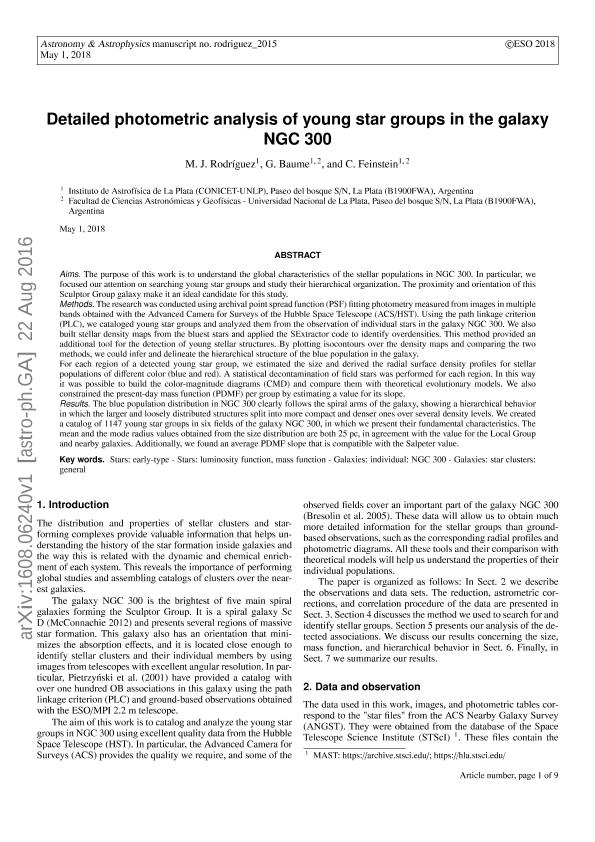Artículo
Detailed photometric analysis of young star groups in the galaxy NGC 300
Fecha de publicación:
10/2016
Editorial:
EDP Sciences
Revista:
Astronomy and Astrophysics
ISSN:
0004-6361
Idioma:
Inglés
Tipo de recurso:
Artículo publicado
Clasificación temática:
Resumen
Aims: The purpose of this work is to understand the global characteristics of the stellar populations in NGC 300. In particular, we focused our attention on searching young star groups and study their hierarchical organization. The proximity and orientation of this Sculptor Group galaxy make it an ideal candidate for this study. Methods: The research was conducted using archival point spread function (PSF) fitting photometry measured from images in multiple bands obtained with the Advanced Camera for Surveys of the Hubble Space Telescope (ACS/HST). Using the path linkage criterion (PLC), we cataloged young star groups and analyzed them from the observation of individual stars in the galaxy NGC 300. We also built stellar density maps from the bluest stars and applied the SExtractor code to identify overdensities. This method provided an additional tool for the detection of young stellar structures. By plotting isocontours over the density maps and comparing the two methods, we could infer and delineate the hierarchical structure of the blue population in the galaxy. For each region of a detected young star group, we estimated the size and derived the radial surface density profiles for stellar populations of different color (blue and red). A statistical decontamination of field stars was performed for each region. In this way it was possible to build the color-magnitude diagrams (CMD) and compare them with theoretical evolutionary models. We also constrained the present-day mass function (PDMF) per group by estimating a value for its slope. Results: The blue population distribution in NGC 300 clearly follows the spiral arms of the galaxy, showing a hierarchical behavior in which the larger and loosely distributed structures split into more compact and denser ones over several density levels. We created a catalog of 1147 young star groups in six fields of the galaxy NGC 300, in which we present their fundamental characteristics. The mean and the mode radius values obtained from the size distribution are both 25 pc, in agreement with the value for the Local Group and nearby galaxies. Additionally, we found an average PDMF slope that is compatible with the Salpeter value.
Palabras clave:
STAR CLUSTERS
,
GALAXY: NGC 300
,
STAR FORMATION
,
MASS FUNCTION
Archivos asociados
Licencia
Identificadores
Colecciones
Articulos(IALP)
Articulos de INST.DE ASTROFISICA LA PLATA
Articulos de INST.DE ASTROFISICA LA PLATA
Citación
Rodriguez, Maria Jimena; Baume, Gustavo Luis; Feinstein Baigorri, Carlos; Detailed photometric analysis of young star groups in the galaxy NGC 300; EDP Sciences; Astronomy and Astrophysics; 594; 10-2016; 34-42
Compartir
Altmétricas




